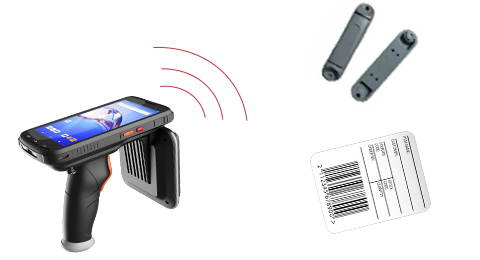400-9920-618
1D and 2D barcode labels and RFID labels are common tags on the market today, which can be seen everywhere in shopping malls, warehouse and logistics, and even in production. Among them, RFID electronic tags are more and more widely used, so what is the difference between RFID tags and barcode tags?

1. Different tags forms
The barcode tag is displayed by printing the bars of different thickness or 2D graphics, and the number is obtained by optical means.
The RFID tag can be considered as the electronic version of the barcode. Its working principle is the radio principle. The information in the RFID tag chip is obtained through the process of electromagnetic wave carrier wave and modulation. RFID is not limited by size and shape in reading, as well as printing quality of paper. In addition, RFID tags can be further miniaturized and developed in various forms to be applied to different products.
2. Scanning speed
Barcodes reading will take more time and requires close alignment reading. Objects cannot be read if they are not facing the reader correctly or are blocked, and only one barcode can be read at a time. The RFID reader can simultaneously identify and read several RFID tags within a certain range, and can penetrate non-metallic or non-transparent materials such as paper, wood and plastic.
3. Label usage environment
In traditional paper printing barcodes, damaged barcodes cannot be read in harsh environments. The RFID tag stores data in the chip, and has strong resistance to water, oil and chemicals, so it can be protected from contamination.
4. Label capacity
The capacity of one-dimensional barcode is 50Bytes, the large capacity of two-dimensional barcode can store 2 to 3000 characters, and the large capacity of RFID has several MegaBytes. With the development of memory carriers, the data capacity also has a trend of expanding. In the future, the amount of data that items need to carry will increase, and the demand for expanding the capacity of labels will also increase accordingly.
5. Reusability
Today's barcodes cannot be changed after being printed, while RFID tags can repeatedly add, modify, and delete data stored in the RFID label, which is convenient for information updating.
6. Label anti-counterfeiting ability
The content of the barcode cannot be changed, but can be copied and reused.
The RFID tag carries electronic information, and its data content can be protected by a password, so that its content is not easy to be forged and altered. Its unique identifier cannot be copied and is a unique number. The content of the tag can be read and written repeatedly.
Shenzhen Handheld-Wireless always offer industrial handheld terminals device and customized application solutions,which support 1D/2D barcode scanner,RFID reading etc in different project application.